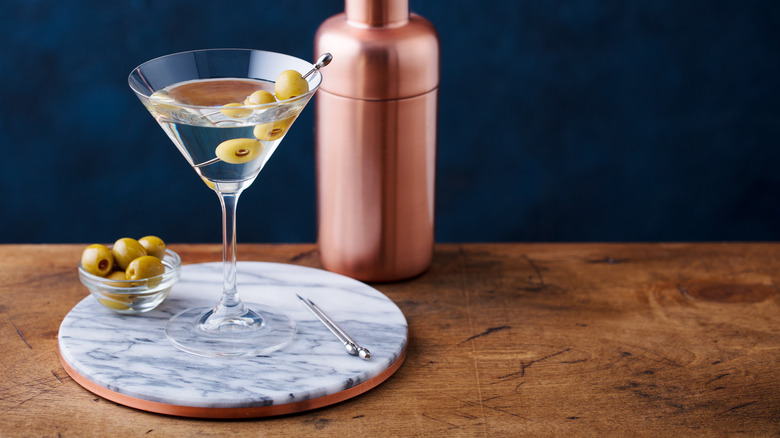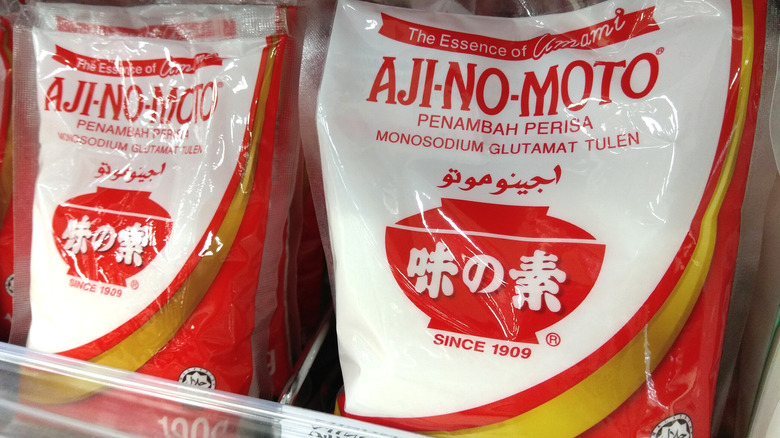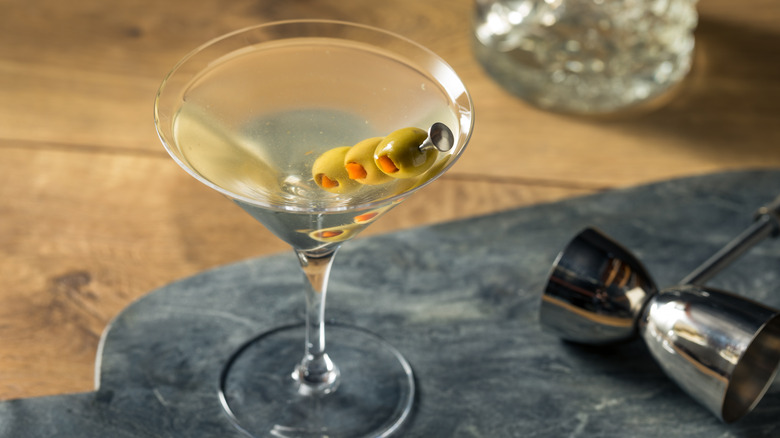For An Extra Dirty Martini, Add MSG To The Mix
While the origins of the martini cocktail are a little mysterious, some claim that its iconic olive garnish is easier to trace. Supposedly, during Prohibition, New York bartender Robert Agneau started popping it into drinks at speakeasies. This was because the briny olives helped to disguise the harsh taste of illegal "bathtub gin" (via The Little Black Book of Martinis). That said, others claim that its roots go further back to 1901 and the experiments of another famous New York barman, John O'Connor.
At some point though, someone decided that a dinky olive just wasn't enough — what about adding a splash of the accompanying brine too? Voila — you've got the world's first dirty martini. This transformed the classic martini cocktail recipe of gin or vodka, vermouth, syrup, and orange bitters (contemporary versions omit the last two), into a decidedly murkier drink. With a dirty martini — such as this recipe from Liquor – you tend to get a pale green, lagoon-like visual effect and a taste that's utterly delicious (if you have a penchant for salt, that is). And over the past century or so, the dirty martini has collected loyal fans, including President Franklin D. Roosevelt (Gentleman's Journal even has his precise recipe).
The cocktail ingredient you didn't know you needed
No doubt many consider the classic dirty martini to be perfection — but that hasn't stopped others from wanting to improve upon it. For instance, the Filthy Martini ramps up the olive brine quota, turning the drink into a salty voyage (via Vine Pair). Yet one of the strangest variations has got to be the MSG Martini.
You may have heard of MSG (monosodium glutamate) as that fiendishly "moreish" substance often added to Chinese restaurant dishes for added deliciousness. But what is it, exactly? In fact, it's been around since 1908 and was invented by Kikunae Ikeda of Tokyo Imperial University. He was also the first person to identify umami (meaning "savory" or "delicious" in Japanese) as a distinct flavor alongside sweet, salty, bitter, and sour. He then isolated it, combining it with sodium to create the food seasoning MSG, which quite literally makes your mouth water — and makes food taste better as a result (via Healthline). And of course, cocktails deserve a little MSG action too.
Here's how to make a fashionable MSG Martini
Channing Centeno, bartender at popular Brooklyn Cantonese restaurant, Bonnie's, certainly thought so. He experimented with adding MSG to a dirty gin martini which, according to Atlas Obscura, makes for a pleasantly soup-like effect (that said, it's arguably not a "real" martini as it swaps the vermouth for traditional Chinese Shaoxing rice wine).
And as outlined by Cook's Illustrated, to make it you need 2 ½ ounces of gin or vodka, 1 ounce of MSG olive brine, and a ½ ounce of Shaoxing wine. Combine in a mixer with ice, strain into a cocktail glass, then garnish with three olives. And the MSG olive brine? The Kitchn suggests making your own solution by dissolving one part MSG in 50 parts water, then adding in brine to taste.
So there you have it — an utterly filthy, murky, outrageously umami martini. It seems that tasty savory cocktails don't stop at Bloody Marys, after all.


